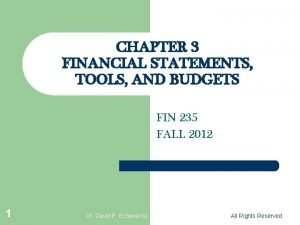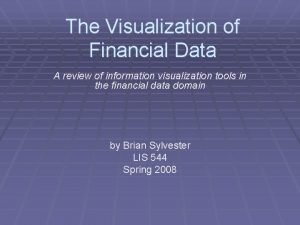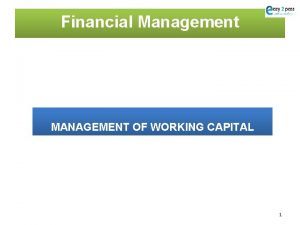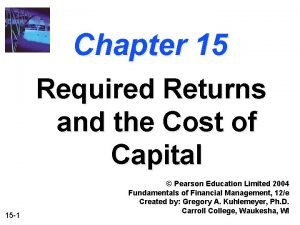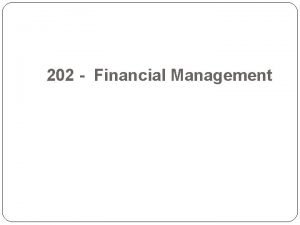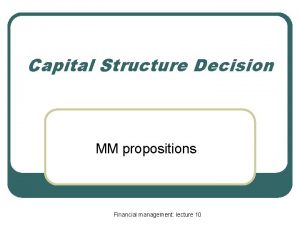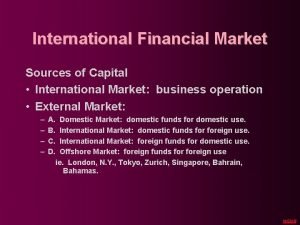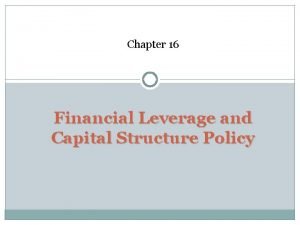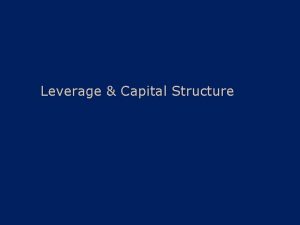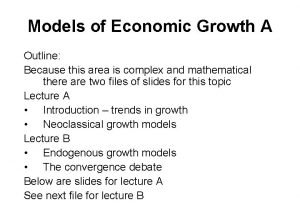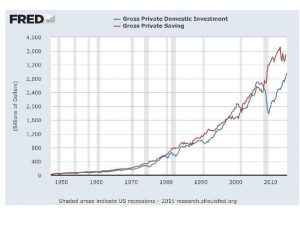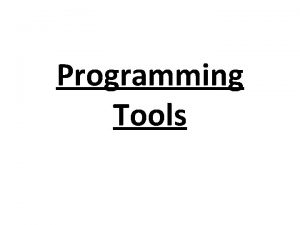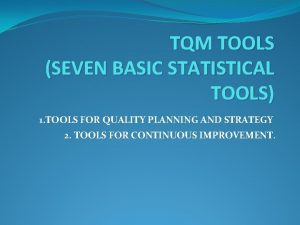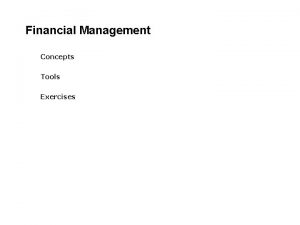Physical Capital vs Financial Capital Physical capital Tools
































- Slides: 32


Physical Capital vs. Financial Capital Ø Physical capital • Tools, instruments, machines, buildings, and other items that have been produced in the past and that are used today to produce goods and services. Ø Financial capital • The funds that firms use to buy physical capital.

Capital and Investment Ø Capital Stock (K) • Total amount of capital measured at a given point in time. Ø Gross investment (I) • total amount spent on purchases of new capital and on replacing depreciated capital. Ø Depreciation (capital consumption allowance) • decrease in the quantity of capital that results from wear and tear and obsolescence. Ø Net investment (IN) • change in the quantity of capital. • I - CCA Ø K(t) = K(t-1) + IN




Wealth and Saving Ø Wealth (W) • the value of all the things that people own. Ø Saving (S) • the amount of income that is not paid in taxes or spent on consumption goods and services. Ø Wealth increases with • Saving (S) • Capital gains (CG) Ø Wealth is decreased by capital losses or dissaving. Ø W(t) = W(t-1)+S(t-1)+ CG(t-1)

Markets for financial capital Ø Saving is the source of funds used to finance investment. Ø These funds are supplied and demanded in three types of financial markets: • Loan markets • Bond markets • Stock markets

Financial Institutions and markets Financial institution • a firm that operates on both sides of the markets for financial capital. • borrower in one market and a lender in another. Types of financial institutions (more on this later) Investment banks • Commercial banks • Government-sponsored mortgage lenders • Pension funds • Insurance companies •

The Market for Loanable Funds Market where households, firms, governments, and financial institutions borrow and lend. The market influences Ø Saving and investment Ø Interest rates

The Market for Loanable Funds The market for loanable funds is the aggregate of all the individual financial markets. Funds that Finance Investment 1. Household saving S 2. Government budget surplus (T -Tr – G) 3. Loans from the rest of the world (M – X) Because Income Side of GDP = Expenditure Side of GDP C + S + (T-Tr) = C + I + G + (X-M) I = S + TN-G + (M-X) where TN=T-Tr (net taxes)

The Market for Loanable Funds Ø Nominal interest rate • More specific name for “interest rate” • Not adjusted for effects of inflation • ($ of interest / $ of principal) period of time Ø Real interest rate • nominal interest rate adjusted to remove the effects of inflation on the purchasing power of money. • nominal interest rate minus the inflation rate.

The Market for Loanable Funds Demand for loanable funds Ø the relationship between the quantity of loanable funds demanded and the real interest rate, ceteris paribus. Ø Business investment is the main item that makes up the demand for loanable funds.

The Market for Loanable Funds Changes in the Demand for Loanable Funds (a shift in the demand curve) Ø When expected profits rises, the demand for loanable funds rises Ø Tax policy can affect demand for loanable funds • Investment tax credit • Accelerated depreciation.

The Market for Loanable Funds Ø The Supply of Loanable Funds • the relationship between the quantity of loanable funds supplied and the real interest rate, ceteris paribus. • Saving is the main item that makes up the supply of loanable funds.

Supply of Loanable Funds

The Market for Loanable Funds Ø Changes in the supply of loanable funds • Driven by changes in willingness to lend (save) at various interest rates • Permanent Income hypothesis is that household consumption in any given year matches their “permanent income” – – • Predictions from PIH regarding savings behavior – – – • If income>permanent income, save If income<permanent income, borrow or dissave Temporary changes in disposable income Expected future income Unexpected changes in wealth Perceived default risk of borrowers will also affect loan supply to a particular group of borrowers

The Market for Loanable Funds: Equilibrium

The Market for Loanable Funds • Assuming no government or international sector, • SLF= Saving • DLF=Investment • Analyze effects of each of the following on Saving, Investment, real interest rate. • A technological advance that creates profitable investment opportunities. • Households become more optimistic about future income growth. • Government creates more tax incentives for business investment.

Government in the Market for Loanable Funds Government enters the loan market when it has a budget surplus or deficit. • A government budget surplus increases the supply of funds • A government budget deficit increases the demand for funds.

Gross government saving includes federal, state and local government.

Government Surplus in the Market for Loanable Funds

Government Deficit in the Market for Loanable Funds

Government in the Market for Loanable Funds: Ricardo-Barro Effect

Government in the Market for Loanable Funds: Ricardo-Barro Effect

The Global Loanable Funds Market • The loanable funds market is global, not national. • Financial capital is mobile: It moves to the best advantage of lenders and borrowers. • Because lenders are free to seek the highest real interest rate and borrowers are free to seek the lowest real interest rate, the loanable funds market is a single, integrated, global market. • Funds flow into the country in which the real interest rate is highest and out of the country in which the real interest rate is lowest.

The Global Loanable Funds Market International Borrowing and Lending Ø If a country’s net exports are negative, • Country is a net borrower • quantity of loanable funds in that country is greater than national saving. Ø If a country’s net exports are positive, • the country is a net lender • the quantity of loanable funds in that country is less than national saving.


Foreign Holdings of U. S. Government Bonds (Billions of $) Total Foreign Holdings = $5, 557. 2 b.



The Global Loanable Funds Market X-M<0 (e. g. U. S. today) X-M>0 (e. g. China today)
 Sewing tools measuring tools
Sewing tools measuring tools Financial business tools ib
Financial business tools ib Project financial management tools
Project financial management tools Financial statements tools
Financial statements tools Conceptual tools of financial engineering
Conceptual tools of financial engineering Financial data visualization tools
Financial data visualization tools Non financial methods of motivation
Non financial methods of motivation Long term financing
Long term financing Cost of capital in financial management
Cost of capital in financial management What is capital access financial system
What is capital access financial system What is working capital in financial management
What is working capital in financial management Capital structure in financial management
Capital structure in financial management Capital markets and financial intermediation
Capital markets and financial intermediation Capital international financial
Capital international financial Financial markets and the allocation of capital
Financial markets and the allocation of capital Financial leverage and capital structure policy
Financial leverage and capital structure policy Business risk and financial risk leverage
Business risk and financial risk leverage Financial leverage and capital structure policy
Financial leverage and capital structure policy Pediatric physical therapy assessment tools
Pediatric physical therapy assessment tools Physical progress and financial progress
Physical progress and financial progress Net working capital refers to
Net working capital refers to Difference between capital reserve and reserve capital
Difference between capital reserve and reserve capital Multinational capital structure
Multinational capital structure Difference between capital reserve and reserve capital
Difference between capital reserve and reserve capital Regulatory capital vs economic capital
Regulatory capital vs economic capital Regulatory capital vs economic capital
Regulatory capital vs economic capital Constant capital and variable capital
Constant capital and variable capital Multinational cost of capital and capital structure
Multinational cost of capital and capital structure Capital allocation line vs capital market line
Capital allocation line vs capital market line Physical capital per worker formula
Physical capital per worker formula Physical capital per worker formula
Physical capital per worker formula Hans rosling washing machine youtube
Hans rosling washing machine youtube Physical capital
Physical capital



